Royal Arms of England
| Royal Arms of England | |
|---|---|
.svg.png) | |
| Details | |
| Armiger | Monarchs of England |
| Adopted | High Middle Ages |
| Escutcheon | Gules three lions passant guardant in pale Or armed and langued azure. |
| Supporters | Various |
| Motto | Dieu et mon droit |
| Orders | Order of the Garter |
| Use |
Quartered in current royal arms; National symbol of England |
The Royal Arms of England are the armorials (or coat of arms) first adopted in a fixed form[1] at the start of the age of heraldry (circa 1200) as personal arms by the Plantagenet kings who ruled England from 1154.[2] In the popular mind they have come to symbolise the nation of England, although according to heraldic usage nations do not bear arms, only persons and corporations do.[3] The blazon of the Arms of Plantagenet is: Gules, three lions passant guardant in pale or armed and langued azure,[4][5] signifying three identical gold lions (also known as leopards) with blue tongues and claws, walking past but facing the observer, arranged in a column on a red background. Although the tincture azure of tongue and claws is not cited in many blazons, they are historically a distinguishing feature of the Arms of England. This coat, designed in the High Middle Ages, has been variously combined with those of the Kings of France, Scotland, A symbol of Ireland, Nassau and Hanover, according to dynastic and other political changes occurring in England, but has not altered since it took a fixed form in the reign of King Richard I (1189–1199), the second Plantagenet king.
Although in England the official blazon refers to "lions", French heralds historically used the term "leopard" to represent the lion passant guardant, and hence the arms of England, no doubt, are more correctly blazoned, "leopards". Without doubt the same animal was intended, but different names were given according to the position; in later times the name lion was given to both.[6]
Royal emblems depicting lions were first used by the Norman dynasty,[7][8][9] later a formal and consistent English heraldry system emerged at the end of the 12th century. The earliest surviving representation of an escutcheon, or shield, displaying three lions is that on the Great Seal of King Richard I (1189-1199), which initially displayed one or two lions rampant, but in 1198 was permanently altered to depict three lions passant, perhaps representing Richard I's principal three positions as King of the English, Duke of the Normans, and Duke of the Aquitaines.[5][7][8][9] In 1340, King Edward III of England laid claim to the throne of France, and thus adopted the Royal arms of France which he quartered with his paternal arms, the Royal Arms of England.[7] Significantly he placed the French arms in the 1st and 4th quarters of greatest honour, signifying the feudal superiority of France over England (The King of France was the feudal overlord of the Duke of Aquitaine). This quartering was adjusted, abandoned and restored intermittently throughout the Middle Ages as the relationship between England and France changed. When the French king altered his arms from semée of fleur-de-lys, to only three, the English quartering eventually followed suit. After the Union of the Crowns in 1603, when the Kingdom of England and the Kingdom of Scotland entered a personal union, the arms of England and Scotland were marshalled (combined) in what has now become the Royal coat of arms of the United Kingdom.[10] It appears in a similar capacity to represent England in the Arms of Canada and on the Queen's Personal Canadian Flag.[11] The coat of three lions continues to represent England on several coins of the pound sterling, forms the basis of several emblems of English national sports teams[12][13] (although with altered tinctures) and endures as one of the most recognisable national symbols of England.[3]
When the Royal Arms are in the format of an heraldic flag, it is variously known as the Royal Banner of England,[14] the Banner of the Royal Arms,[15] the Banner of the King (Queen) of England,[16][17] or by the misnomer the Royal Standard of England.[note 1] This Royal Banner differs from England's national flag, the St George's Cross, in that it does not represent any particular area or land, but rather symbolises the sovereignty vested in the rulers thereof.[4]
History
Origins

.jpg)
Lions had previously been used by the Norman dynasty as royal emblems, and Attributed arms have been invented for kings who pre-dated the systematisation of hereditary English heraldry that occurred in the second half of the 12th century.[7] King Henry II of England (1133–1189) had used a coat with a lion on it;[19] his children experimented with different combinations of lions. King Richard I (1189–1199) used a single lion rampant, or perhaps two lions affrontés, on his first seal,[5] but later used three lions passant in his 1198 Great Seal of England, and thus established the lasting design of the Royal Arms of England.[5][19] Although King John (1199–1216) had a seal in 1177, with two lions passant guardant, the three lions passant or on a field gules were used as the Royal Arms (or King's Arms) by Kings John (1199–1216), Henry III (1216–1272), Edward I (1272–1307), and Edward II (1307–1327).[5]
Development
In 1340, following the death of King Charles IV of France, Edward III asserted a claim to the French throne through his mother Isabella of France. In addition to initiating the Hundred Years' War, Edward III expressed his claim in heraldic form by quartering the royal arms of England with the Arms of France. This quartering continued until 1801, with intervals in 1360–1369 and 1420–1422.[5]
Following the death of Queen Elizabeth I of England in 1603, the throne of England was inherited by the Scottish House of Stuart, resulting in the Union of the Crowns: the Kingdom of England and Kingdom of Scotland were united in a personal union under King James VI and I.[20] As a consequence, the Royal Arms of England and Scotland were combined in the king's new personal arms. Nevertheless, although referencing the personal union with Scotland and Ireland, the Royal Arms of England remained distinct from the Royal Arms of Scotland, until the two realms were joined in a political union in 1707, leading to a unified Royal coat of arms of the United Kingdom.[10]
| Escutcheon | Period | Description | ||||
|---|---|---|---|---|---|---|
.svg.png) | 1066–1154 | William the Conqueror is said to have brought two golden lions passant, the symbol of the Duchy of Normandy, to England, following the Norman Conquest.[18] The blazon of the attributed arms of William I, William II and Henry I is "Gules, two lions passant guardant in pale or".[21] | ||||
.svg.png) | 1133–1189 | Arms of Henry II, King of England, and Duke of Normandy. Only by later tradition did Henry II come to be said to have used the arms that now designate the Duchy of Normandy (gules, two lions passant guardant in pale or)'[22] | ||||
.svg.png) | 1189–1198 | The arms of Richard I of England (Richard the Lionheart) are only known from two armorial seals, and hence the tinctures can not be determined. His First Great Seal showed one lion on half of the shield. It is debated whether this was meant to represent two lions combatant or a single lion, and if the latter, whether the direction in which the lion is facing is relevant or simply an artistic liberty. A simple lion rampant is most likely.[23] | ||||
.svg.png) | 1198–1340 1360–1369 | The arms on the second Great Seal of King Richard the Lionheart, used by his successors until 1340: Gules, three lions passant guardant in pale or (Three golden lions on a red field, representing the ruler of the Kingdom of England, Duchy of Normandy and the Duchy of Aquitaine).[5][7] | ||||
.svg.png) | 1340–1360 1369–1395 1399–1406 | King Edward III adopted the Royal Arms of France Azure semé of fleurs de lys or (powdering of fleurs-de-lis on a blue field) and quartered the Royal Arms of England – representing his claim to the French throne. | ||||
.svg.png) | 1395–1399 | King Richard II impaled the Royal Arms of England with the attributed arms of King Edward the Confessor. | ||||
.svg.png) | 1406–1422 | King Henry IV, imitating Charles VI of France, reduced the fleurs-de-lis to three.[7][24] | ||||
.svg.png) | 1422–1461 1470–1471 | King Henry VI impaled the French and English arms, symbolising the dual monarchy of England and France. | ||||
.svg.png) | 1461–1470 1471–1554 | King Edward IV restored the arms of King Henry IV.[24] | ||||
.svg.png) | 1554–1558 | Queen Mary I and King Philip impaled their arms. Philip's arms were: A. Arms quarterly Castile and Leon, B. per pale Aragon and Aragon-Sicily, the whole enté en point Granada; in base quarterly Austria, Burgundy ancient, Burgundy modern and Brabant, with an escutcheon (in the nombril point) per pale Flanders and Tyrol.[7][24] Although Queen Mary I's father, King Henry VIII, assumed the title of King of Ireland and this was further conferred upon King Philip, the arms were not altered to feature the Kingdom of Ireland.
| ||||
.svg.png) | 1558–1603 | Queen Elizabeth I restored the arms of King Henry IV.[7] | ||||
.svg.png) | 1603–1649 1660–1689 |
James VI, King of Scots, inherited the English and Irish thrones in 1603 in the Union of the Crowns, and quartered the Royal Arms of England with those of Scotland. The Royal Arms of Ireland was added to represent the Kingdom of Ireland. Last used by Queen Anne, this was the final version of the Royal Arms of England before being subsumed into the Royal Arms of Great Britain.[7][24] | ||||
.svg.png) | 1689–1694 |
King James II is deposed and replaced with his daughter Mary and son-in-law and nephew William. As co-monarchs, they impaled their arms: William bore the Royal Arms with the addition of an escutcheon of Nassau (the royal house to which William belonged): Azure billetty or, a lion rampant of the last armed and langued gules, while Mary bore the Royal Arms undifferenced.[26] | ||||
.svg.png) | 1694–1702 |
After the death of Queen Mary II, King William III reigned alone, and used his arms only.[7] | ||||
.svg.png) | 1702–1707 |
Queen Anne inherited the throne upon the death of King William III, and the Royal Arms returned to the 1603 version.[7] |
Union with Scotland and Ireland

On 1 May 1707, the kingdoms of England and Scotland were merged to form that of Great Britain; this was reflected by impaling their arms in a single quarter. The claim to the French throne continued, albeit passively, until it was mooted by the French Revolution and the formation of the French First Republic in 1792.[5] During the peace negotiations at the Conference of Lille, from July to November 1797, the French delegates demanded that the King of Great Britain abandon the title of King of France as a condition of peace. The Acts of Union 1800 united the Kingdom of Great Britain with the Kingdom of Ireland to form the United Kingdom of Great Britain and Ireland. Under King George III of the United Kingdom, a proclamation of 1 January 1801 set the royal style and titles and modified the Royal Arms, removing the French quarter and putting the arms of England, Scotland and Ireland on the same structural level, with the dynastic arms of Hanover moved to an inescutcheon.[5]
| Escutcheon | Period | Description |
|---|---|---|
.svg.png) | 1707–1714 | The impaled arms of England and Scotland reflecting their merging into one kingdom of "Great Britain". |
.svg.png) | 1714–1801 | The 2nd quarter was replaced with a set of arms showing the origins of the House of Hanover as a result of the Act of Settlement. |
.svg.png) | 1801–1816 | The arms showing the status of the constituent realms of the United Kingdom: England, Scotland and Ireland. The Hanoverian dynastic arms have been moved to an inescutcheon with an electoral bonnet. |
.svg.png) | 1816–1837 | The arms showing Hanover raised to the status of a kingdom after the Napoleonic wars. |
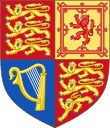 | 1837–present | The Hanoverian dynastic arms have been dropped on the accession of Queen Victoria. As Hanover followed the salic law, she could not accede to the throne of Hanover. |
Contemporary
English heraldry flourished as a working art up to around the 17th century, when it assumed a mainly ceremonial role.[5] The Royal Arms of England continued to embody information relating to English history.[5] Although the Acts of Union 1707 placed England within the Kingdom of Great Britain, prompting new, British Royal Arms, the Royal Arms of England has continued to endure as one of the national symbols of England,[3] and has a variety of active uses. For instance, the coats of arms of both The Football Association[12][27] and the England and Wales Cricket Board[28] have a design featuring three lions passant, based on the historic Royal Arms of England. In 1997 (and again in 2002), the Royal Mint issued a British one pound (£1) coin featuring three lions passant to represent England.[29] To celebrate St George's Day, in 2001, Royal Mail issued first– and second-class postage stamps with the Royal Crest of England (a crowned lion), and the Royal Arms of England (three lions passant) respectively.[30]
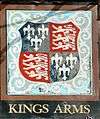 The Royal Arms of England as depicted on the Kings Arms pub in Blakeney, Norfolk
The Royal Arms of England as depicted on the Kings Arms pub in Blakeney, Norfolk A British one pound (£1) coin, issued in 1997, featuring three lions passant, representing England.[29]
A British one pound (£1) coin, issued in 1997, featuring three lions passant, representing England.[29] A modern, commercially available Royal Banner of England, printed on polyester fabric
A modern, commercially available Royal Banner of England, printed on polyester fabric.jpg) The coat of arms of the Football Association (granted by the College of Arms in 1949), worn by the England national football team, are based on the Royal Arms of England.[12][13]
The coat of arms of the Football Association (granted by the College of Arms in 1949), worn by the England national football team, are based on the Royal Arms of England.[12][13]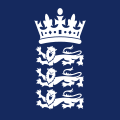 The coat of arms worn by England cricket team, the national football team removed the original crown to distinguish it from the cricket team in 1949.[31]
The coat of arms worn by England cricket team, the national football team removed the original crown to distinguish it from the cricket team in 1949.[31]
Crest, supporters and other parts of the achievement
Various accessories to the escutcheon (shield) were added and modified by successive English monarchs. These included a crest (with mantling, helm and crown); supporters (with a compartment); a motto; and the insignia of an order of knighthood. These various components made up the full achievement of arms.[24]
Royal crest
.svg.png)
The first addition to the shield was in the form of a crest borne above the shield. It was during the reign of Edward III that the crest began to be widely used in English heraldry. The first representation of a royal crest was in Edward's third Great Seal, which showed a helm above the arms, and thereon a gold lion passant guardant standing upon a chapeau, and bearing a royal crown on its head.[32] The design underwent minor variations until it took on its present form in the reign of Henry VIII: "The Royal Crown proper, thereon a lion statant guardant Or, royally crowned also proper".[32]
The exact form of crown used in the crest varied over time. Until the reign of Henry VI it was usually shown as an open circlet adorned with fleurs-de-lys or stylised leaves. On Henry's first seal for foreign affairs the design was altered with the circlet decorated by alternating crosses formy and fleurs-de-lys. From the reign of Edward IV the crown bore a single arch, altered to a double arch by Henry VII. The design varied in details until the late 17th century, but since that time has consisted of a jewelled circlet, above which are alternating crosses formy and fleurs-de-lys. From this spring two arches decorated with pearls, and at their intersection an orb surmounted by a cross formy.[32] A cap of crimson velvet is shown within the crown, with the cap's ermine lining appearing at the base of the crown in lieu of a torse.[32] The shape of the arches of the crown has been represented differently at different times, and can help to date a depiction of the crest.[32]
The helm on which the crest was borne was originally a simple steel design, sometimes with gold embellishments. In the reign of Elizabeth I a pattern of helm unique to the Royal Arms was introduced. This is a gold helm with a barred visor, facing the viewer.[33] The decorative mantling (a stylised cloth cloak that hangs from the helm) was originally of red cloth lined with ermine, but was altered to cloth of gold lined ermine by Elizabeth.[33]
Supporters
.jpg)
Animal supporters, standing on either side of the shield to hold and guard it, first appeared in English heraldry in the 15th century. Originally, they were not regarded as an integral part of arms, and were subject to frequent change. Various animals were sporadically shown supporting the Royal Arms of England, but it was only with the reign of Edward IV that their use became consistent. Supporters fell under the regulation of the Kings of Arms in the Tudor period. The heralds of that time also prochronistically created supporters for earlier monarchs, and although these attributed supporters were never used by the monarchs concerned, they were later used to signify them on public buildings or monuments completed after their deaths, for instance at St. George's Chapel, in Windsor Castle.[34][35]
The boar adopted by Richard III prompted William Collingbourne's quip "The Rat, the Cat, and Lovell the Dog, Rule all England under the Hog",[note 2][24] and William Shakespeare's derision in Richard III.[note 3][36] The red dragon, a symbol of the Tudor dynasty, was added upon the accession of the Henry VII.[24] After the Union of the Crowns, the supporters of the arms of the British monarch have remained as the Lion and the Unicorn, representing England and Scotland respectively.[24]
| Period | Description |
|---|---|
| Edward III
(1327–1377) |
Lion and falcon (attributed); Two lions; two angels |
| Richard II
(1377–1399) |
Two white harts (attributed) |
| Henry IV
(1399–1413) |
Lion and antelope; antelope and swan (attributed); Two angels |
| Henry V
(1413–1422) |
Lion and antelope (attributed) |
| Henry VI
(1422–1461) |
Two antelopes argent; lion and panther; antelope and tiger (attributed) |
| Edward IV
(1461–1483) |
Lion or and bull sable; lion argent and hart argent; two lions argent |
| Edward V
(1483) |
Lion argent and hart argent, gorged and chained or |
| Richard III
(1483–1485) |
Lion or and boar argent; two boars argent; boar argent and bull sable |
| Henry VII
(1485–1509) |
Dragon gules and greyhound argent; two greyhounds argent; lion or and dragon gules |
| Henry VIII
(1509–1547) |
Lion or and dragon gules; dragon gules and bull sable; dragon gules and greyhound argent; dragon gules and cock argent |
| Edward VI
(1547–1553) |
Lion or and dragon gules |
| Mary I
(1553–1554) |
Lion or and dragon gules; lion or and greyhound argent |
| Philip and Mary I
(1554–1558) |
Eagle sable and lion or |
| Elizabeth I
(1558–1603) |
Lion or and dragon or; lion or and greyhound argent |
| James I
From 1603 |
Lion gardant or, regally crowned proper and unicorn argent, armed unguled, and crined or, gorged with a coronet composed of crosses paty and fleurs-de-lis or, a chain affixed thereto passing between the forelegs and reflexing over the back or |
Garter and motto
Edward III founded the Order of the Garter in about 1348. Since then, the full achievement of the Royal Arms has included a representation of the Garter, encircling the shield. This is a blue circlet with gold buckle and edging, bearing the order's Old French motto Honi soit qui mal y pense ("Shame be to him who thinks evil of it") in gold capital letters.[33]
A motto, placed on a scroll below the Royal Arms of England, seems to have first been adopted by Henry IV in the early 15th century. His motto was Souverayne ("sovereign").[33] His son, Henry V adopted the motto Dieu et mon droit ("God and my right"). While this motto has been exclusively used since the accession of George I in 1714, and continues to form part of the Royal Arms of the United Kingdom, other mottoes were used by certain monarchs in the intervening period.[33] Veritas temporis filia ("truth is the daughter of time") was the motto of Mary I (1553–1558), Semper Eadem ("always the same") was used by Elizabeth I (1558–1603) and Anne (1702–1714), James I (1603–1625) sometimes used Beati pacifici ("blessed are the peacemakers"), while William III (1689–1702) used the motto of the House of Orange: Je maintiendrai ("I will maintain").[33]
As a banner
.jpg)
The Royal Banner of England is the English banner of arms and so has always borne the Royal Arms of England—the personal arms of England's reigning monarch. When displayed in war or battle, this banner signalled that the sovereign was present in person.[18] Because the Royal Banner depicted the Royal Arms of England, its design and composition changed throughout the Middle Ages.[18] It is variously known as the Royal Banner of England, the Banner of the Royal Arms,[15] the Banner of the King of England, or by the misnomer of the Royal Standard of England; Arthur Charles Fox-Davies explains that it is "a misnomer to term the banner of the Royal Arms the Royal Standard", because "the term standard properly refers to the long tapering flag used in battle, by which an overlord mustered his retainers in battle".[15] The archaeologist and antiquarian Charles Boutell also makes this distinction.[18] This Royal Banner differs from England's national flag, St George's Cross, in that it does not represent any particular area or land, but rather symbolises the sovereignty vested in the rulers thereof.[4]
When displayed in war or battle, this banner signalled that the sovereign was present in person.[18] Because the Royal Banner depicted the Royal Arms of England, so its design and composition changed throughout the Middle Ages.[18]
In other banners
 The Banner of the Duchy of Lancaster viz the Royal Banner of England defaced with a blue label of three points, each point containing three fleur-de-lis.
The Banner of the Duchy of Lancaster viz the Royal Banner of England defaced with a blue label of three points, each point containing three fleur-de-lis.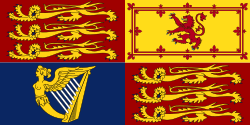 The Royal Banner of the United Kingdom featuring the Royal Banner of England in the first and fourth quarters.
The Royal Banner of the United Kingdom featuring the Royal Banner of England in the first and fourth quarters..svg.png) The Royal Banner of the United Kingdom used in Scotland, featuring the Royal Banner of England in the second quarter.
The Royal Banner of the United Kingdom used in Scotland, featuring the Royal Banner of England in the second quarter. The Queen's Personal Canadian Flag, featuring the Royal Banner of England in the First quarter of the first two divisions.
The Queen's Personal Canadian Flag, featuring the Royal Banner of England in the First quarter of the first two divisions.
Other roles and manifestations
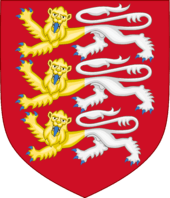
Several ancient English towns displayed the Royal Arms of England upon their seals and, when it occurred to them to adopt insignia of their own, used the Royal Arms, albeit with modification, as their inspiration.[39] For instance, in the arms of New Romney, the field is changed from red to blue.[39] Hereford changes the lions from gold to silver, and in the 17th century was granted a blue border charged with silver saltires in allusion to its siege by a Scottish army during the English Civil War.[39] The town council of Faversham changes only the hindquarters of the three lions to silver.[38] Berkshire County Council bore arms with two golden lions in reference to its Royal patronage and the Norman kings' influence upon the early history of Berkshire.[39]
The Royal Arms of England features on the tabard, the distinctive traditional garment of English officers of arms.[40] These garments were worn by heralds when performing their original duties—making royal or state proclamations and announcing tournaments. Since 1484 they have been part of the Royal Household.[41] Tabards featuring the Royal Arms continue to be worn at several traditional ceremonies, such as the annual procession and service of the Order of the Garter at Windsor Castle, the State Opening of Parliament at the Palace of Westminster, the coronation of the British monarch at Westminster Abbey, and state funerals in the United Kingdom.[40]
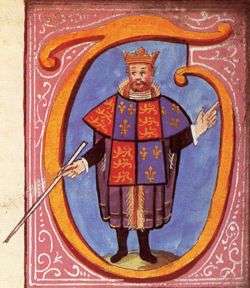 Thomas Hawley, an English officer of arms, wearing a tabard emblazoned with the Royal Arms of England
Thomas Hawley, an English officer of arms, wearing a tabard emblazoned with the Royal Arms of England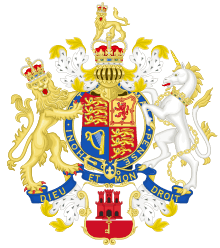 The Arms of the Gibraltarian Government, which was granted by the College of Arms in 1836 to commemorate the Great Siege of Gibraltar, features the Royal Arms of England.[42]
The Arms of the Gibraltarian Government, which was granted by the College of Arms in 1836 to commemorate the Great Siege of Gibraltar, features the Royal Arms of England.[42] Edward, the Black Prince, wearing a surcoat emblazoned with the Royal Arms of England
Edward, the Black Prince, wearing a surcoat emblazoned with the Royal Arms of England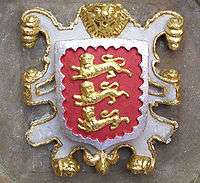 The arms of Oriel College, Oxford alludes to the institution's regal foundation by using the Royal Arms of England with a silver border added for difference.[43]
The arms of Oriel College, Oxford alludes to the institution's regal foundation by using the Royal Arms of England with a silver border added for difference.[43] The Flag of Detroit uses a stylized version of the Royal Arms to symbolize former British control of the city from 1760-1796
The Flag of Detroit uses a stylized version of the Royal Arms to symbolize former British control of the city from 1760-1796
See also
- Royal Badges of England
- Royal coat of arms of Scotland
- Royal coat of arms of the United Kingdom
- Royal coat of arms of France
- Coat of arms of Spain
- Coat of arms of the Crown of Aragon
- Coat of arms of Norway
Notes
- ↑ In A Complete Guide to Heraldry (1909), Arthur Charles Fox-Davies explains:
The archaeologist and antiquarian Charles Boutell also makes this distinction.[18]“ It is a misnomer to term the banner of the Royal Arms the Royal Standard. The term standard properly refers to the long tapering flag used in battle, by which an overlord mustered his retainers in battle.[15] ” - ↑ This was a pun on Richard III (the Hog) and three of his staunchest supporters, Richard Ratcliffe (the Rat), William Catesby (the Cat) and Francis Lovell (the Dog).
- ↑ For instance, in Act 1, Scene III of Richard III, Margaret, Queen consort of England describes Richard as "Thou elvish-mark'd, abortive, rooting hog!"
References
Citations
- ↑ King Henry II (1154-1189) used proto-heraldic arms, showing one or two lions
- ↑ Jamieson 1998, pp. 14–15.
- 1 2 3 Boutell 1859, p. 373: "The three golden lions upon a ground of red have certainly continued to be the royal and national arms of England."
- 1 2 3 Fox-Davies 2008, p. 607.
- 1 2 3 4 5 6 7 8 9 10 11 The First Foot Guards. "Coat of Arms of King George III". footguards.tripod.com. Retrieved 4 February 2010.
- ↑ Parker, James. "A Glossary of Terms Used in Heraldry". A Glossary of Terms Used in Heraldry. Retrieved 18 September 2015.
- 1 2 3 4 5 6 7 8 9 10 11 Brooke-Little 1950, pp. 205–222
- 1 2 Brooke-Little 1981, pp. 3–6
- 1 2 Paston-Bedingfield & Gwynn-Jones 1993, pp. 114–115.
- 1 2 The Royal Household. "Union Jack". royal.gov.uk. Archived from the original on 30 June 2013. Retrieved 28 August 2009.
- ↑ The Public Register of Arms, Flags and Badges of Canada. "The Flag of Her Majesty the Queen for personal use in Canada". gg.ca. Retrieved 28 August 2009.
- 1 2 3 Briggs 1971, pp. 166–167.
- 1 2 Ingle, Sean (18 July 2002). "Why do England have three lions on their shirts?". guardian.co.uk. Retrieved 15 September 2010.
- ↑ Thompson 2001, p. 91.
- 1 2 3 4 Fox-Davies 1909, p. 474.
- ↑ Keightley 1834, p. 310.
- ↑ James 2009, p. 247.
- 1 2 3 4 5 6 7 Boutell 1859, pp. 373–377.
- 1 2 Ailes, Adrian (1982). The Origins of The Royal Arms of England. Reading: Graduate Center for Medieval Studies, University of Reading. pp. 52–63.
- ↑ Ross 2002, p. 56.
- ↑ Hassler 1980, p. 6.
- ↑ Brooke-Little, J.P., FSA (1978) [1950]. Boutell's Heraldry (Revised ed.). London: Frederick Warne LTD. pp. 205–222. ISBN 0-7232-2096-4.
- ↑ Ailes. pp. 52–3, 64–74.
- 1 2 3 4 5 6 7 8 9 Knight 1835, pp. 148–150.
- ↑ (Spanish) Francisco Olmos, José María de. «Las primeras acuñaciones del príncipe Felipe de España (1554–1556): Soberano de Milán Nápoles e Inglaterra». «The First Coins of Prince Philip of Spain (1554–1556): Sovereign of Milan, Naples and England», pp. 165–166. Documenta & Instrumenta, 3 (2005). Madrid, Universidad Complutense. PP. 155–186.
- ↑ Arnaud Bunel's Héraldique européenne site
- ↑ "England Football Online – The Three Lions". englandfootballonline.com. Retrieved 15 September 2010.
- ↑ England Wales Cricket Board
- 1 2 Royal Mint (2010). "The United Kingdom £1 Coin". royalmint.com. Retrieved 15 September 2010.
- ↑ "Three lions replace The Queen on stamps". telegraph.co.uk. 6 March 2001. Retrieved 15 September 2010.
- ↑ Why Do England’s Cricketers Wear the Iconic Crest on Their Chest? Retrieved on 10 September 2012. The Cricket Blog.
- 1 2 3 4 5 Brooke-Little 1981, pp. 4–8.
- 1 2 3 4 5 6 Brooke-Little 1981, p. 16.
- ↑ Brooke-Little 1981, p. 9.
- ↑ Paston-Bedingfield & Gwynn-Jones 1993, p. 117.
- ↑ Hall 1853, p. 74.
- ↑ Woodward 1997, pp. 50–54.
- 1 2 Faversham Town Council (2010). "Faversham Coat of Arms". The Faversham Website. faversham.org. Retrieved 16 September 2010.
- 1 2 3 4 5 Scott-Giles 1953, p. 11.
- 1 2 College of Arms. "The history of the Royal heralds and the College of Arms". college-of-arms.gov.uk. Retrieved 20 September 2010.
- ↑ Elston, Laura (8 September 2009). "Herald's tabard". The Independent. independent.co.uk. Retrieved 20 September 2010.
- ↑ Sumner 2001, p. 9.
- ↑ "The name and arms of the College". oriel.ox.ac.uk. Archived from the original on 24 June 2009. Retrieved 20 September 2010.
Sources
- Boutell, Charles (1859). "The Art Journal London". 5. Virtue: 373–376.
- Briggs, Geoffrey (1971). Civic and Corporate Heraldry: A Dictionary of Impersonal Arms of England, Wales and N. Ireland. London: Heraldry Today. ISBN 0-900455-21-7.
- Brooke-Little, J.P., FSA (1978) [1950]. Boutell's Heraldry (Revised ed.). London: Frederick Warne LTD. ISBN 0-7232-2096-4.
- Brooke-Little, J.P., FSA, MVO, MA, FSA, FHS (1981). Royal Heraldry. Beasts and Badges of Britain. Derby: Pilgrim Press Ltd. ISBN 0-900594-59-4.
- Fox-Davies, Arthur Charles (2008) [1909]. A Complete Guide to Heraldry. READ.
- Hall, Samuel Carter (1853). The Book of British Ballads. H. G. Bohn.
- Hassler, Charles (1980). The Royal Arms. ISBN 0-904041-20-4.
- James, George Payne Rainsford (2009). The History of Chivalr y. General Books LLC.
- Jamieson, Andrew Stewart (1998). Coats of Arms. Pitkin. ISBN 978-0-85372-870-2.
- Knight, Charles (18 April 1835). "English Regal Arms and Supporters". The Penny Magazine. 4. Society for the Diffusion of Useful Knowledge.
- Keightley, Thomas (1834). The crusaders; or, Scenes, events, and characters, from the times of the crusades. 2 (3rd ed.). J. W. Parker.
- Paston-Bedingfield, Henry; Gwynn-Jones, Peter (1993). Heraldry. Greenwich Editions. ISBN 0-86288-279-6.
- Robson, Thomas (1830). The British Herald. Turner & Marwood.
- Ross, David (2002). Chronology of Scottish History. Geddes & Grosset. ISBN 1-85534-380-0.
- Scott-Giles, Wilfrid (1953). Civic Heraldry of England and Wales (2nd ed.). London: J M Dent & Sons.
- Sumner, Ian (2001). British Colours & Standards 1747–1881 (2): Infantry. Osprey Publishing. ISBN 1-84176-201-6.
- Thomson, D. Croal (2001). Fifty Years of Art, 1849–1899: Being Articles and Illustrations Selected from 'The Art Journal'. Adegi Graphics LLC.
- Woodward, Jennifer (1997). The Theatre of Death: The Ritual Management of Royal Funerals in Renaissance England, 1570–1625. Boydell & Brewer. ISBN 978-0-85115-704-7.
| Wikimedia Commons has media related to |
.svg.png)
.svg.png)
